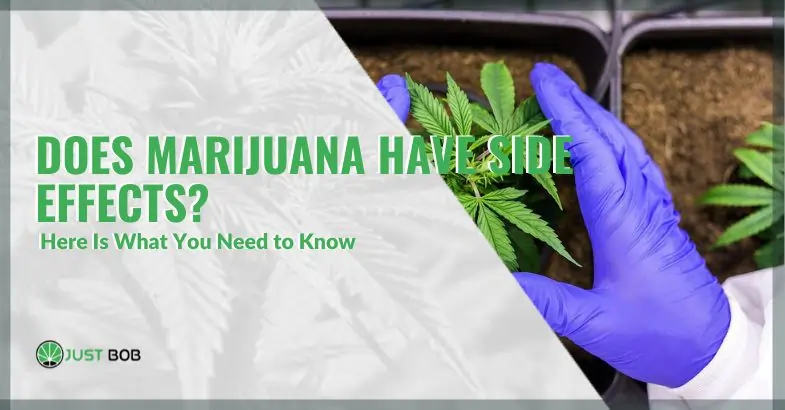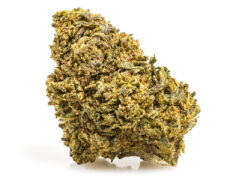Modified on: 16/03/2025
Exploring the Landscape of Marijuana’s Impact: A Detailed Look at Potential Side Effects
Marijuana, a substance derived from the Cannabis sativa plant, has a long and multifaceted history of use, spanning medicinal, spiritual, and recreational contexts.
The primary psychoactive compound within marijuana, delta-9-tetrahydrocannabinol (THC), interacts with the body’s intricate endocannabinoid system, a network of receptors and neurotransmitters involved in regulating various physiological processes. This interaction is responsible for the diverse effects experienced by users.
As is well known, its consumption is prohibited by law in the UK and most European countries, with medical exceptions for so-called medical cannabis. But there is no doubt that its use is becoming more widespread every year as more and more countries around the world become open to its consumption.
While some individuals seek out marijuana for its purported therapeutic properties or the feelings of relaxation and euphoria it can induce, a comprehensive understanding necessitates an honest appraisal of the potential downsides. Therefore, delving into the spectrum of potential side effects, both those that manifest shortly after use and those that may develop over time with chronic consumption, is crucial for informed decision-making and public health awareness.


The Immediate Aftermath: Unpacking the Short-Term Effects of Marijuana
Upon consumption, the journey of THC through the body is relatively rapid. Whether inhaled through smoking or vaping, or ingested through edibles, THC quickly enters the bloodstream and is transported to the brain and other organs. This rapid distribution leads to a cascade of immediate effects that can vary significantly from person to person.
The intensity and nature of these effects are influenced by a multitude of factors, including the dosage consumed, the specific method of intake (as edibles tend to have a delayed but more prolonged effect compared to inhalation), an individual’s unique physiology and tolerance levels, and the frequency with which they use marijuana.
From a psychological standpoint, one of the hallmark effects of marijuana is an alteration in sensory perception. Colors may appear more vivid, music can sound richer and more immersive, and even tactile sensations can be amplified. Accompanying these sensory shifts is often a distortion in the perception of time. Moments can feel elongated, as if time is slowing down, or conversely, events can seem to rush by in a blur.
The euphoric feelings and mood elevation frequently associated with marijuana use are driven by THC’s influence on the brain’s reward system. However, this positive emotional shift is not universally experienced. For some individuals, particularly those prone to anxiety or who consume higher doses, marijuana can trigger feelings of unease, paranoia, or even full-blown panic attacks.
The cognitive domain is also notably impacted in the short term. Memory function, particularly short-term memory, can be impaired, making it difficult to recall recent events or conversations. Attention and concentration levels may also wane, hindering the ability to focus on tasks or engage in complex problem-solving. In rare instances, particularly with very high doses or in individuals with pre-existing mental health vulnerabilities, the psychological effects can be more pronounced, potentially leading to hallucinations or delusional thinking.
The physical manifestations of short-term marijuana use are also readily observable. The tell-tale sign of red, bloodshot eyes is a common occurrence, resulting from the dilation of blood vessels in the eyes caused by THC. Dry mouth, often referred to as “cottonmouth,” is another frequent side effect, stemming from the interaction of cannabinoids with saliva production. The notorious “munchies,” characterized by a significant increase in appetite, are well-documented and linked to THC’s influence on appetite-regulating hormones.
Furthermore, marijuana can affect motor skills and coordination. Reaction times may be slowed, and fine motor control can be impaired, which is a critical consideration in situations requiring physical dexterity or quick responses. An increase in heart rate is a typical physiological response to marijuana, and while generally not dangerous for healthy individuals, it can be a concern for those with pre-existing cardiovascular conditions.
ome users might experience dizziness or drowsiness, which can further contribute to impaired coordination. Although less common, nausea or even vomiting can occur in some individuals, particularly those who are new to marijuana use or who consume excessive amounts.
Read also: Hashish effects: here the most known in the field
Navigating the Long Road: Exploring the Long-Term Effects of Marijuana Consumption
While the immediate effects of marijuana are often transient, chronic use can lead to more enduring and potentially serious health consequences that impact various aspects of an individual’s well-being. These long-term effects are a subject of ongoing research, but a growing body of evidence highlights several areas of concern.
The relationship between prolonged marijuana use and mental health is a complex and closely studied area. Evidence suggests a correlation between chronic marijuana use, especially when initiated during adolescence, and an increased risk of developing certain mental health disorders. While not a direct causal link in all cases, studies have shown an association between long-term marijuana use and higher rates of depression and anxiety disorders.
The respiratory system bears the brunt of the negative consequences of smoking marijuana. Similar to tobacco smoke, marijuana smoke contains numerous irritants and carcinogens. Chronic marijuana smokers are more likely to experience symptoms of chronic bronchitis, such as persistent coughing, increased mucus production, and wheezing. While the definitive link between marijuana smoking and lung cancer is still under investigation and requires more extensive research, the inhalation of combusted plant material is inherently damaging to the delicate tissues of the lungs and should be a cause for concern for regular smokers.
The cardiovascular system is also vulnerable to the long-term effects of marijuana use. The acute increases in heart rate and potential elevations in blood pressure observed in the short term can, over time, contribute to a higher risk of cardiovascular events. This is particularly relevant for older adults or individuals with pre-existing heart conditions, where the added strain on the cardiovascular system could exacerbate underlying issues.
It’s worth noting that another compound found in cannabis, cannabidiol (CBD), is distinct from THC and is non-psychoactive. CBD is available in various forms for collecting and aromatherapy, such as CBD oils, legal hash and CBD weed, and is studied for its potential therapeutic benefits without the intoxicating effects associated with marijuana.
The Vulnerable Years: Examining the Impact on Adolescents and Young Adults
The developing brains of adolescents and young adults are particularly susceptible to the potentially harmful effects of marijuana. This period of rapid neurological growth and maturation makes the brain more vulnerable to disruption by external substances like THC. Early and frequent marijuana use during these critical years can have lasting consequences on cognitive development. Research suggests that such use can interfere with the normal pruning and strengthening of neural connections, potentially leading to long-term impairments in areas such as memory, learning, and executive functions like planning and decision-making.
Beyond cognitive impacts, adolescents and young adults who use marijuana regularly face a heightened risk of developing mental health disorders. The association between early marijuana use and an increased risk of conditions like anxiety, depression, and even psychotic disorders is a significant concern. Furthermore, studies have indicated a correlation between adolescent marijuana use and decreased academic and occupational achievement. The cognitive impairments and motivational changes associated with regular use can hinder educational progress and impact future career prospects. Therefore, understanding the unique vulnerabilities of this age group is crucial for targeted prevention efforts and for fostering informed decision-making among young people.


A Time of Caution: Considering Marijuana Use During Pregnancy and Breastfeeding
The use of marijuana during pregnancy and breastfeeding raises significant concerns regarding the health and development of the child. Research has established associations between marijuana use during pregnancy and several adverse outcomes. These include an increased risk of low birth weight and preterm birth, which can have significant implications for the infant’s health. Importantly, THC can cross the placental barrier, meaning the developing fetus is directly exposed to the psychoactive compound. This exposure can interfere with fetal brain development, potentially leading to long-term neurological and behavioral issues in the child.
Similarly, THC is known to be present in breast milk. This means that a nursing infant can also be exposed to THC through breastfeeding. While the long-term effects of this exposure are still being studied, concerns exist regarding its potential influence on the newborn’s developing brain and overall health. Given these potential risks, leading medical organizations generally advise against marijuana use during pregnancy and while breastfeeding to protect the health and well-being of the child.
Impaired Judgment and Reaction: The Dangers of Driving and Operating Machinery
Marijuana significantly impairs several cognitive and motor functions that are crucial for the safe operation of vehicles and heavy machinery. The effects of THC on motor coordination, reaction times, and judgment can dramatically increase the risk of accidents and injuries. Studies have consistently shown a correlation between marijuana use and an increased risk of being involved in traffic accidents. The slowed reaction times and impaired decision-making abilities can be particularly dangerous in dynamic situations requiring quick responses.
Similarly, operating heavy machinery under the influence of marijuana poses a significant safety hazard, both to the operator and to those around them. Therefore, it is imperative to avoid operating vehicles or machinery after consuming marijuana to prevent potentially life-threatening situations.
The Web of Interactions: Considering Other Substances and Legal Boundaries
Combining marijuana with other substances, such as alcohol, can exacerbate the impairing effects of both substances and significantly increase the likelihood of adverse consequences. The combined effects can lead to greater cognitive and motor impairment, increasing the risk of accidents, injuries, and poor decision-making. Furthermore, it is crucial to be aware of potential interactions between marijuana and prescription medications. Marijuana can influence the metabolism and efficacy of certain drugs, potentially leading to unintended side effects or reducing the effectiveness of prescribed treatments. It is essential to inform healthcare providers about marijuana use, especially when taking other medications.
The legal status of marijuana varies significantly across different regions and jurisdictions, ranging from complete prohibition to allowing for medical or recreational use. It is imperative to be fully informed about the local laws regarding marijuana possession, use, and cultivation to avoid potential legal repercussions, which can include fines, arrests, and even imprisonment. Beyond the legal aspects, social considerations also play a role. While societal acceptance of marijuana use has increased in some areas, it can still carry social stigma or lead to interpersonal conflicts, particularly if use becomes excessive, problematic, or conflicts with personal or professional responsibilities. Open communication and respect for differing viewpoints are important in navigating these social dynamics.
Read also: CBD cannabis: the effects of legal marijuana
Drawing the Lines: A Concluding Perspective on Marijuana’s Side Effects
While marijuana possesses certain therapeutic properties and is used recreationally by many, it is essential to acknowledge that it is not without potential side effects. Both the immediate and long-term use of marijuana can lead to a range of psychological and physical health issues that warrant careful consideration.
Therefore, approaching marijuana use with an informed and balanced perspective is paramount. Weighing the potential benefits against the potential risks, understanding the legal and social context, and practicing moderation are all crucial aspects of responsible decision-making.
We hope our article has satisfied your questions and if you want to find out everything there is to know about the world of cannabis, including legal cannabis, keep following us here on the Justbob blog!
Marijuana side effects: takeaways
- Understanding the immediate consequences of marijuana consumption is crucial for anyone considering its use. Shortly after intake, individuals may experience a range of psychological alterations, from euphoria and heightened sensory perception to anxiety and paranoia. Cognitive functions can be temporarily impaired, affecting memory and attention span, while physical manifestations often include dry mouth, red eyes, and an increased appetite. These short-term effects are generally transient, but their intensity and nature can vary significantly depending on individual factors and the potency of the marijuana consumed, underscoring the importance of being aware of these potential immediate changes in both mental and physical states.
- The potential for long-term health implications associated with chronic marijuana use presents a significant concern that warrants careful consideration. Research indicates links between prolonged exposure to marijuana and an elevated risk of mental health disorders, particularly in vulnerable individuals. Furthermore, regular smoking of marijuana can have detrimental effects on the respiratory system, mirroring some of the risks associated with tobacco use. The cardiovascular system can also be impacted, with increased heart rate and potential blood pressure fluctuations. Moreover, the development of cannabis use disorder, involving dependence and withdrawal symptoms, is a recognized risk, highlighting that the notion of marijuana being entirely harmless is a misconception that needs to be addressed with factual information.
- Navigating the complexities surrounding marijuana requires a balanced perspective, acknowledging both its potential applications and its inherent risks. Although some individuals may explore marijuana for its perceived benefits, provided of course that local laws allow it, it is essential to be fully informed about the possible side effects, both immediately after use and in the case of long-term use. Factors such as age, pre-existing health conditions, and concurrent use of other substances can significantly influence the impact of marijuana. Therefore, approaching this topic with awareness and a commitment to understanding the science behind its effects is paramount, ensuring informed decisions are made based on a comprehensive understanding of the potential consequences rather than solely on anecdotal experiences or popular misconceptions.
Marijuana side effects: FAQ
What are the most common short-term side effects of using marijuana?
The immediate aftermath of marijuana consumption can bring about a variety of noticeable effects, both in mind and body. Psychologically, individuals might experience a sense of euphoria or heightened mood, alongside altered sensory perception where colors seem brighter or sounds more distinct. However, this can sometimes be accompanied by anxiety, paranoia, or even panic, particularly with higher doses or in individuals prone to anxiety. Cognitively, short-term memory and attention span can be impaired, making it harder to focus or recall recent events. Physically, common side effects include dry mouth, often described as “cottonmouth,” and bloodshot eyes due to dilated blood vessels. An increase in appetite, the well-known “munchies,” is also a frequent occurrence. Furthermore, coordination and motor skills may be affected, leading to slower reaction times. The intensity and combination of these short-term effects can vary considerably from person to person based on various factors like dosage and individual sensitivity.
Can long-term marijuana use really impact mental health, and if so, how?
The relationship between long-term marijuana use and mental health is a complex area of ongoing research, but there is growing evidence suggesting a potential link, particularly with frequent and heavy use. Studies have shown an association between chronic marijuana use and an increased risk of developing certain mental health disorders, such as anxiety and depression. More concerning is the potential connection to more severe conditions like psychosis and schizophrenia, although this link is more pronounced in individuals with a pre-existing vulnerability or family history of these disorders. The exact mechanisms are still being investigated, but it’s thought that the long-term effects of THC on brain chemistry and neural pathways could contribute to these increased risks. It’s important to note that correlation does not equal causation, and more research is needed to fully understand the nature and extent of this relationship. However, the existing evidence suggests that long-term marijuana use is a factor to consider in the context of mental health, especially for vulnerable individuals.
Is marijuana truly addictive, and what are the signs of withdrawal?
Despite common misconceptions, marijuana does have the potential for addiction, and the development of cannabis use disorder is a recognized condition. While the addictive potential may be lower than some other substances, a significant number of individuals who use marijuana regularly can develop dependence. This dependence manifests as a strong urge or craving to use marijuana, difficulty controlling or cutting down use despite wanting to, and continued use despite negative consequences. Upon attempting to stop or significantly reduce marijuana use, some individuals experience withdrawal symptoms. These symptoms can vary in intensity but often include irritability, anxiety, sleep disturbances such as insomnia, decreased appetite, restlessness, and mood swings. In some cases, individuals may also experience physical discomfort. The presence of these withdrawal symptoms is a key indicator of dependence and highlights the fact that marijuana is not entirely without addictive potential, emphasizing the importance of responsible use and awareness of the potential for developing a cannabis use disorder.









